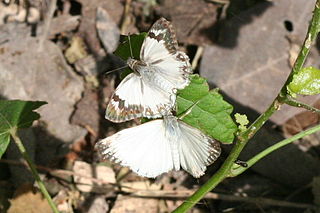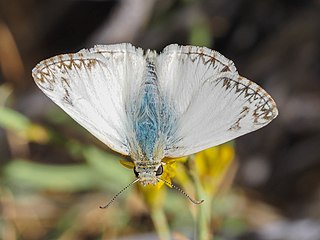
Pyrgus is a genus in the skippers butterfly family, Hesperiidae, known as the grizzled skippers. The name "checkered" or "chequered skipper" may also be applied to some species, but also refers to species in the genera Burnsius and Carterocephalus. They occur in the Holarctic with an additional group of species extending to the Neotropic.
Agathymus neumoegeni is commonly referred to as the orange giant-skipper, Neumogen's giant-skipper, Neumogen's agave borer, Neumogen's moth-skipper, and tawny giant-skipper.

Heliopetes is a Neotropical genus of spread-winged skipper butterflies in the family Hesperiidae.

Cecropterus toxeus, also known as the coyote cloudywing or coyote skipper, is a species of butterfly in the family Hesperiidae. It is found from Panama, north through Central America and Mexico to central Texas. Strays can be found up to southern Arizona.

Burnsius albezens, the white checkered-skipper, formerly known as Burnsius albescens and Pyrgus albescens, is a species of skipper. It is found at low altitudes in the southern United States and Mexico. It is a rare stray to southwest Utah and central Texas and is found in a variety of dry, open habitats.

Burnsius philetas, the desert checkered-skipper, formerly known as Pyrgus philetas, is a species of skipper butterfly in the family Hesperiidae. It is found from the southern United States (southern Arizona east to southern Texas, and to southern Mexico. Individuals are also found north to northern Arizona and northern Texas.

Lerodea eufala, the Eufala skipper or rice leaffolder, is a species of butterfly in the family Hesperiidae. It is found from the coast of Georgia, south through Florida and west across the southern United States to southern California, south through Mexico and Central America to Patagonia. In the summer, it expands its range north to central California, North Dakota, southern Wisconsin, northern Michigan and Washington, D.C.

Anthanassa frisia, the Cuban crescentspot, Cuban checkerspot or Cuban crescent, is a butterfly of the family Nymphalidae. Subspecies tulcis is known by the common names pale-banded crescent or Tulcis crescent; it is treated as a species by some authors.

Calpodes ethlius, the Brazilian skipper, larger canna leafroller or canna skipper, is a butterfly of the family Hesperiidae. It is found in the United States from southern Florida and southern Texas, south through the West Indies, Mexico, and Central America to Argentina. Strays and temporary colonies can be found north to southern Nevada, northern Texas, Illinois and Massachusetts.

Phocides polybius, the bloody spot or guava skipper, is a species of butterfly in the skipper family, Hesperiidae, that is native to the Americas. It is found from the lower Rio Grande Valley of southern Texas in the United States south through Mexico and Central America to Argentina. The species was first described by Johan Christian Fabricius in 1793.

Cecropterus dorantes, the lilac-banded longtail or Dorantes longtail, is a species of butterfly in the family Hesperiidae. It is found from Argentina, north through Central America, Mexico, and the West Indies to southern Texas and peninsular Florida. Strays can be found as far north as northern California, southern Arizona, southern Missouri and North Carolina.

Chiothion asychis, the white-patched skipper or white patch, is a species of butterfly in the family Hesperiidae. It is found from Argentina, north through tropical America to the West Indies and southern Texas. Strays can be found as far north as southern Arizona, Nevada and Kansas.

Heliopetes macaira, the Turk's-cap white-skipper , is a butterfly of the family Hesperiidae. It is found from southern Texas in North America, south through Central America to Paraguay.

Celotes nessus, the common streaky-skipper, is a butterfly of the family Hesperiidae. It is found in North America from southern Arizona, southern New Mexico, and western Texas south to northern Mexico. Rare strays can be found up to southern Oklahoma and northern Louisiana.

Chlosyne fulvia, the Fulvia checkerspot, is a butterfly of the family Nymphalidae. It is found in North America from Kansas, Colorado, southern Utah and Arizona south to central Mexico.

Ochlodes sylvanoides, the woodland skipper, is a butterfly of the family Hesperiidae. It is found in North America from British Columbia south to southern California, east to Montana, Colorado and Arizona.

Anthanassa texana, the Texan crescentspot, is a species of butterfly in the family Nymphalidae. It is found from Guatemala north through Mexico to southern California, east across the southern United States to northern Florida, Georgia and South Carolina. Strays may be found up to Arkansas, Missouri, Illinois, South Dakota, and central Nevada. The habitat consists of deserts, dry gulches, open areas, streamsides, road edges, and city parks.

Lon melane, also known as the umber skipper, is a butterfly of the family Hesperiidae. It is found in California, southern Arizona, Baja California, the highlands of Mexico and Central America. The habitat consists of desert foothills, grassy areas, streamsides, roadsides, yards, parks and open oak woodland.

Heliopetes ericetorum, the northern white-skipper, is a butterfly of the family Hesperiidae. It is found in North America in the United States from eastern Washington south to western Colorado, southern California and Arizona, and in Baja California in north-western Mexico. The habitat consists of open woodland, chaparral, dry washes, desert mountains and arid lands.



















